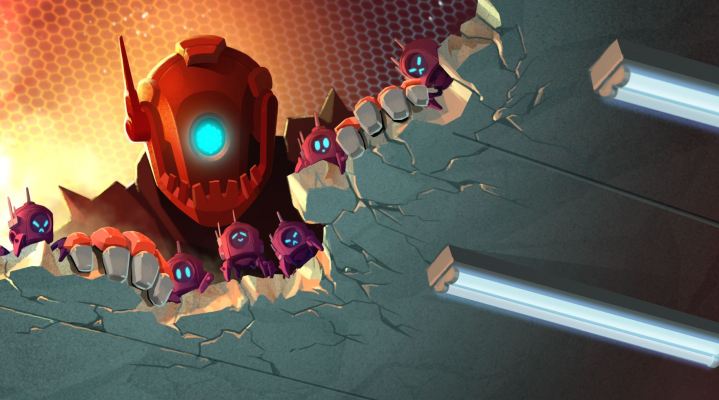For reasons unbeknownst to me, we’re currently living in a second golden age for 2D beat ’em up games. That trend began in 2020 when Dotemu released the fantastic Streets of Rage 4 and has only continued with hits like Teenage Mutant Ninja Turtles: Shredder’s Revenge. Players currently seem to be resonating with those modern-retro releases, but nostalgic genre revivals can be a double-edged sword. Even the genre’s greatest hits are filled with frustrating gameplay quirks that tend to carry over into faithful throwbacks. The developers at Gylee Games don’t want to run into that trap with its own addition to the genre’s canon, Ra Ra Boom.
On paper, the colorful beat ‘em up looks pretty similar to a game like Shredder’s Revenge, with up to four players pounding robots in 2D side-scrolling levels. Speaking with the team at this year’s Game Developers Conference, though, it’s clear that Gylee wants to solve issues that have always bugged them about beat ‘em ups, not repeat them. That’s paving the way for a fresh brawler that does away with monotony and focuses on “fast, frenetic, and fabulous” action.
Changing lanes
When I sat down with the team to watch a hands-off demo of the game’s opening, my interest was quickly piqued. The most obviously captivating hook is its Lisa Frank-inspired art style, which bathes its hand-drawn levels in bright colors and cartoon-like animations. The developers tell me that the art got an entire visual overhaul in 2020 after the team saw Streets of Rage 4, prompting them to throw everything they’d drawn out. They felt the bar had been raised that much higher, and it’s clear they were serious about that when seeing it in action.
Though I’m also unexpectedly grabbed by its story. Ra Ra Boom takes place in a post-apocalyptic world where humans create AI robots to try and fix the march of climate change. The robots do exactly that … by killing off all humans. Players take control of four girls living on a space station 20 years later who return to Earth to fight the rogue robots and grapple with some complicated ethical questions.

When we actually dive into the gameplay, I quickly get a sense of where Gylee is trying to deviate from an established genre that’s not exactly known for iteration. That starts with its unique combat system, which combines close-up strikes, ranged attacks, and aerial juggling. In addition to punches, each character has their own gun that can be used to peck away at enemies from across the screen. It isn’t just a gameplay twist for twist’s sake, though. Guns help extend combo potential, allowing players to unload a combo on an enemy, knock them back, and continue that string by peppering them with shots. You don’t have to lose your combo meter just because you’re on the wrong side of the screen.
Gylee Founder Chris Bergman tells me that the combat system was less inspired by other beat ‘em ups and more built from fighting games. In particular, Bergman is a fan of the Marvel vs. Capcom series and cites it as a primary influence. He also compares its shooting to something like Contra, explaining that the team looked to marry the idea of a beat ‘em up and a run-and-gun game. Those ideas make for something that may look like your average brawler on its surface but is an entirely different beast once you dig into its nuances.
Bergman stresses that the team’s goal is to chip away at some of the genre’s monotony, and that pops up in ingenious ways. We agree that one of our biggest frustrations in beat ‘em ups comes from trying to fight waves of enemies on a 2D plane. It can be difficult to perfectly line up with an oncoming enemy, making it easy to whiff attacks. Ra Ra Boom solves that with a clever piece of art direction: The floor of every level is broken out into “lanes.”
If players are on a street, for instance, they’ll see the pavement split up into four horizontal segments that stretch across the screen. That makes it easy for players to see exactly where an enemy is in 2D space and position themselves directly in front of them. It’s so obvious that I’m mad no one thought of it sooner.

That especially comes together in a chaotic final boss fight which has the girls running away from a rogue robot and swapping between lanes to dodge incoming attacks. It’s a frenetic moment as the characters dodge obstacles and beat down smaller robots in their path, but it’s also much easier to parse in some way. I can easily see where an attack is going to land and tell when someone is out of the way. That’s not an accomplishment that even the genre’s best can claim.
What’s especially impressive is that Gylee isn’t a studio made up of veteran game developers. According to Bergman, only one member of the team is from that world. I’m left wondering if that detail is part of the secret to success here. Perhaps Ra Ra Boom is as clever as it is because it’s coming from a team of people who grew up loving beat ‘em ups, but aren’t too precious about the idea of deconstructing them. It feels like it was created by fans who’ve spent a lot of time daydreaming about how they’d fix the things that always bugged them about their favorite games.
Whatever its secret is, I’m excited to see how it all translates into a full-length beat ‘em up. Working with a totally new IP, Gylee won’t have the nostalgia of Streets of Rage or Ninja Turtles under its belt. It doesn’t seem like it’ll need it, though. Instead, its Ra Ra Boom looks toward the future of the genre more than the past. And it does that with the colorful energy of a 90s Trapperkeeper.



